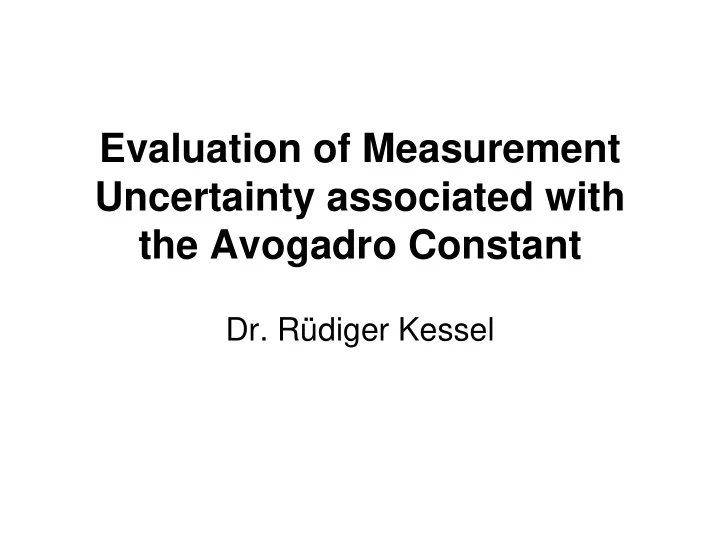

Evaluation of Measurement Uncertainty associated with the Avogadro Constant Dr. Rüdiger Kessel
Agenda • Importance of the Avogadro Number • The international approach in 2002 • The Avogadro Number • The task: establishing the final value – Sub-problem: molar volume – Removing inconsistencies – Treating correlations – Uncertainty budget • Discussion of the final approach
Importance of the Avogadro Number • Why do we need it? • Why do we need to measure it? • How do we measure it ? – Molar mass – Volume – Mass – Lattice parameter • Why is silicon used?
The international approach in 2002 INRIM (IMGC) EU/IRMM Lattice parameter, Molar Mass Density PTB NMI-A Density Density NMIJ Density, Lattice parameter
The Avogadro Number ⋅ n M M V = = ⋅ Si Si N A 3 m a m ⋅ 3 a V n (Si: n = 8 )
Mass Spectrometer at IRMM
Establishing the final value • Results and uncertainty budget have been provided for all measurements of: – Density – Molar mass – Lattice parameter • Two main questions: – What is the measurement function? – How to combine different data?
Sub-problem: molar volume 28.08554 M = Si V ρ m 28.08547 Si Molar mass in g·mol -1 28.0854 Use regression? 28.08533 28.08526 2329.024 2329.03 2329.036 2329.042 2329.048 Density ρ in kg·m -3 (Data intentionally modified)
Why not use regression? • Regression leads to a complicated model equation. • The zero point need to be included. • With the zero point the regression degenerates. • Check of pairwise consistency is difficult.
Use of the weighted mean value M = + δ , Si i V V Individual molar volume ρ m , i m , i Si , i + ⋅ ⋅ + ⋅ ⋅ M r K M r K M = 28 29 / 28 , 29 / 28 29 , 30 / 28 , 30 / 28 30 Si i Si i i Si M + ⋅ + ⋅ , Si i 1 r K r K 29 / 28 , i 29 / 28 30 / 28 , i 30 / 28 1 Individual molar mass ∑ V , m i 2 u ( V ) = i , m i V Weighted mean for the overall molar volume m 1 ∑ 2 ( ) u V i m , i ε = − V V Difference between individual and overall molar volume i m , i m
Removing inconsistencies Before… After… Difference of the molar volume in mol·m -3 Difference of the molar volume in mol·m -3 8·10 -12 4·10 -12 2·10 -12 4·10 -12 0 0 -2·10 -12 -4·10 -12 -4·10 -12 -8·10 -12 ε 1.1 ε 1.2 ε 1.3 ε 1.4 ε 1.1 ε 1.2 ε 1.3 ε 1.4
Overall data consistency Difference of the molar volume in mol·m -3 1.9·10 -11 0 -1.9·10 -11 -3.8·10 -11 ε 01 ε 02 ε 03 ε 04 ε 05 ε 06 ε 07 ε 08 ε 09 ε 10 ε 11 ε 12 ε 13 ε 14 ε 15 ε 16 ε 17 ε 18 ε 19
Treating correlations • Correlations are important because we average over large number of molar volume values • Correlations arise because the laboratories use common quantities for different results (e.g. calibration factor for molar mass) • Results from different laboratories are considered to be independent
Uncertainty budget Quantity Value Standard Sensitivity Uncertainty Index Uncertainty Coefficient Contribution 543.1020880·10 -12 m 16.0·10 -18 m -3.3·10 33 -53·10 15 mol -1 a 0 21.0 % 37.0·10 -6 mol/mol 890·10 18 33·10 15 mol -1 K 29/28Si 1.0013060 mol/mol 8.1 % 58.0·10 -6 mol/mol 1.3·10 21 73·10 15 mol -1 K 30/28Si 0.9963150 mol/mol 39.3 % 220·10 -9 g/mol 20·10 21 4.4·10 15 mol -1 M 28Si 27.976926490 g/mol 0.1 % 1.00·10 -6 12·10 21 12.0·10 15 mol -1 r 30 0.03360280 1.2 % δ V m 5.60·10 -12 2.2·10 27 12.2·10 15 mol -1 0.0 1.2 % ρ 2329.035464 kg/m 3 900·10 -6 kg/m 3 -70·10 18 -62.6·10 15 mol -1 29.1 % 6.0221353·10 23 mol -1 100·10 15 mol -1 N A • 50% of the uncertainty arises from molar mass measurements • 20% from lattice parameter measurements • 30% from density measurements
Discussion of the final approach • clear measurement M = + δ Si , i V V ρ m , i m , i function Si , i • every lab is contributing 1 ∑ V , • weighting based on m i 2 u ( V ) = i , m i V uncertainties m 1 ∑ 2 ( ) u V • check for consistency i m , i ⋅ 8 V = m N A 3 a
Acknowledgement I would like to thank Prof. Paul De Bievre (IRMM, retired) for involving me in the project. I would like to thank Dr. Peter Becker (PTB) for providing me with detailed data and some photos.
Thank you for you attention!
Recommend
More recommend